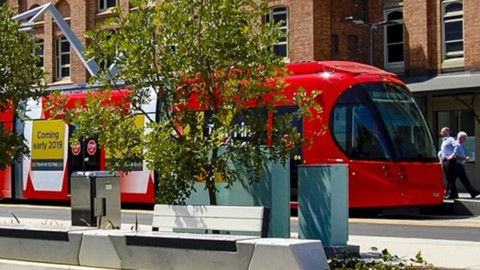With the trade sector facing a skilled worker shortage across a range of industries, the New South Wales Trade Pathways program is looking to boost the number of qualified tradespeople in the state, and is specifically designed to attract and support partially skilled workers, mature workers and women.
The Trade Pathways program is an initiative by the New South Wales Government, and is providing people in the trade sector with the opportunity to acquire qualifications in their fields at no cost, in order to fill skill shortages.
Infrastructure Magazine had the opportunity to speak with Gabrielle Durney, Structural Drafter at Northrop Consulting Engineers and NSW TAFE Trainee of the Year, regarding her career, the Trade pathways program and the issues currently facing those trying to advance in the trade sector.
Gabrielle Durney’s path to a trade
Ms Durney initially began working in the retail industry and said that while she enjoyed her time there and had the opportunity to undertake many different roles, she felt as if her development was stagnating. “I wanted to try something I hadn’t done before and give myself a new challenge,” Ms Durney said.
“To begin researching a potential career change I used the National Skills Commission skills priority list, which identifies all the jobs that don’t have enough skilled workers. I felt that these roles had good job security and would be easier to get a foot in the door.
“Drafting really spoke to me as an emerging skill in a developed industry, I felt like I could be on the forefront of a new wave of technology. The role itself involved good communication skills, creativity and the ability to work independently.” Ms Durney explained that because the role is identified on the skills list, the TAFE course was heavily discounted to encourage applicants.
“I started with the Certificate IV in Engineering Drafting, and within six months I had secured a traineeship to complete the Diploma in Civil Construction Design with Northrop Consulting Engineers. Now that I am in the role, I really enjoy the flexibility, the ongoing learning and the drafting itself I find enjoyable to do.”
Ms Durney explained that it was very difficult to get a start as a mature aged apprentice (MAA), which is defined as an applicant over the age of 25. “As an MAA, businesses have to follow a different award pay grade, which makes mature applicants twice as expensive as young applicants. Instead of just applying to every available position, I focused on applying to medium to large businesses who wouldn’t be as put off by the pay difference.
“The argument from small businesses tends to be that they can’t afford to pay someone a similar rate to a skilled worker when they don’t have any experience for the role. I would argue that skilled workers have significant and valuable experience they can bring.
“Skills such as time management, organisation, communication and personal leadership are also usually developed in an apprenticeship or traineeship, and mature applicants will already have these ready to go. “They only need to be trained in the specific task of their role which is a much smaller ask. There are a lot of benefits for businesses willing to expand their applicant pool and consider people they wouldn’t usually for a role.”
NSW TAFE trainee of the year
At the New South Wales TAFE Excellence Awards in 2023, Ms Durney was recognised as Trainee of the Year, which she said was an unbelievable feeling. “I put a considerable amount of effort into my qualification, I made personal sacrifices and really pushed myself outside my comfort zone.
“To be recognised at the end of it was such a great feeling. It not only felt like a recognition of my work but also the support I received from my network of friends, my family and Northrop Consulting Engineers, especially my manager and mentor Hayden Davis and my fellow trainee Ashbea Suyo.
“It was also fantastic to have that recognition for all the teachers from the program who supported and encouraged not only me but all the students, often working one on one with people to ensure they were successfully absorbing all the material for the course. “I was really taken by their care and effort; every teacher went above and beyond. The award wasn’t just for me, it was also a light shone on Ray Pozzato who nominated me and Dr Amro Ezzeldin the head teacher for Civil Construction.”
Boosting the workforce with education initiatives
Ms Durney explained that the Trade Pathways program is designed to support people who already work in an industry, to recognise experience and shorten the process for receiving a trade qualification. “Sometimes people work in roles where there are qualifications available and don’t go through the formal training process to receive that qualification, such as an office manager who hasn’t completed a traineeship in Office Administration.
“Sometimes, when people try and change companies, the experience in their old role is not recognised towards their ability to do the new role. Having the qualification that certifies you to be able to perform in the role strengthens your application and can translate into your remuneration. This pathway could also be an easier way to work towards a trade qualification without needing to apply for roles as a mature applicant.
“I think more women than men are working in roles without having formal qualifications; I know from working in retail there are plenty of women who could have a Certificate or Diploma in retail operations or a qualification in commercial bakery who have never been given the opportunity to complete a traineeship by their employer. It would be great to see their experience become formally recognised.”
Supporting women in trades
Ms Durney is also a mentor for the Property Council of Australia’s Girl’s in Property program, and said that statistically young women will generally not apply for roles if they haven’t seen a woman working in that field before. “Being a visible role model is one of the easiest ways to encourage more women into your field.
“I am lucky in that Drafting and BIM disciplines report a close to 50/50 gender split, with Northrop Sydney reporting slightly more women than men in these roles. Young women have often not considered there are roles within the construction industry that are not male dominated.
“It’s so important to give girls all their options for their careers. I think schools get so caught up in encouraging young people to apply for university in order to improve their own ranking that they lose sight of communicating all the career options there are. “Every conversation I have with young women highlights the entrenched belief that attending university will make you successful and that TAFE and trade schools are for high school dropouts.
“The girls I spoke to at the most recent event I attended said their parents would be horrified if they suggested attending TAFE instead of university.” Ms Durney said that despite this common outlook, data shows that people who complete trade apprenticeships and traineeships actually not only turn out wealthier than university graduates on average, but they also report better mental health, with less depression, anxiety and loneliness than university graduates.
“I always point out to young women that by choosing a trade, they will have an employer cover the total cost of their training, graduate with no HECS debt and be paid and get experience in their role for the duration of their learning.
“Also, choosing TAFE does not close the door on university, it’s not one or the other. I completed a Certificate IV, then a Diploma, and now I’m studying a Bachelors in Construction Project Management at UTS while still working in my trade.” Ms Durney said that from the perspective of the industry there is also huge benefit in encouraging women into construction.
“It seems shortsighted to not encourage more women to transition to construction roles when we’re faced with such dramatic skills shortages. “Construction teams with women working in them also report less workplace conflict and work more efficiently. From the perspective of project management, female-led teams are more likely to finish projects under budget and within deadlines compared to male-led teams. “Having a better saturation of women in construction could revolutionise the industry.”
















